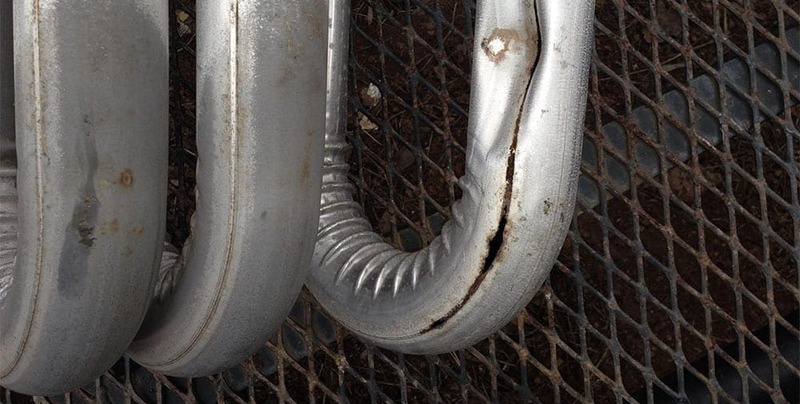This guide will help you understand what a cracked heat exchanger is, why it’s dangerous, and how to spot potential scams.
What Is a Heat Exchanger?
The heat exchanger is a critical component of your furnace. Its job is to separate the combustion process (where fuel is burned to create heat) from the air that circulates through your home. When fossil fuels like natural gas, propane, or oil burn, they produce heat but also release harmful byproducts, including carbon monoxide. The heat exchanger ensures these dangerous gases are safely vented outside while allowing warm air to heat your home.
What Is a Cracked Heat Exchanger?

A cracked heat exchanger occurs when the metal barrier that separates combustion gases from your home’s air develops a break. This crack can allow toxic gases, like carbon monoxide, to leak into your living space. Cracks can form over time due to wear and tear, overheating, or rust. While this is a legitimate safety concern, some contractors may exaggerate or fabricate the issue to sell you a new furnace.
The Dangers of a Cracked Heat Exchanger
A cracked heat exchanger poses significant risks to your household. Carbon monoxide, a colorless and odorless gas, can cause symptoms like headaches, dizziness, nausea, and even death if inhaled in large amounts. Additionally, a cracked heat exchanger can disrupt the furnace’s combustion process, leading to incomplete burning of fuel and producing even more carbon monoxide. If you suspect a crack, it’s crucial to act quickly to protect your family.
Signs of a Cracked Heat Exchanger

How can you tell if your heat exchanger is cracked? Here are some common signs to watch for:
- Unusual Smells: A strong, metallic odor near your furnace could indicate a problem.
- Visible Cracks or Rust: If you can inspect the heat exchanger, look for visible cracks or rust.
- Soot Buildup: Excessive soot around the furnace or flue pipe may signal poor combustion.
- Yellow or Flickering Flames: A healthy furnace flame should be blue and steady. Yellow or flickering flames could indicate a crack.
- Carbon Monoxide Detectors Going Off: If your detectors alarm, take it seriously and investigate immediately.
- Short Cycling: If your furnace turns on and off more frequently than usual, it could be a sign of a cracked heat exchanger.
If you notice any of these symptoms, contact a trusted HVAC professional for an inspection.
How to Avoid Heat Exchanger Scams
Unfortunately, some contractors may falsely claim your heat exchanger is cracked to sell you a new furnace. Here’s how to protect yourself:
- Get a Second Opinion: If a technician claims your heat exchanger is cracked, seek a second opinion from a reputable company.
- Ask for Visual Proof: If a crack is diagnosed, ask to see it yourself. A visible crack should be obvious, even to an untrained eye.
- Check for Consistent Symptoms: A true crack will often cause flame roll-out or high carbon monoxide levels in the flue. If your furnace seems to be running fine, be skeptical of a crack diagnosis.
- Research the Company: Read reviews and ask for recommendations to ensure you’re working with an honest HVAC provider.
What Causes Heat Exchanger Cracks?
Understanding the causes of heat exchanger cracks can help you prevent them. The most common causes include:
- Overheating: Restricted airflow due to a dirty air filter or blocked vents can cause the heat exchanger to overheat and crack.
- Oversized Furnaces: A furnace that’s too large for your home will cycle on and off frequently, leading to excessive wear and tear.
- Rust: Condensation inside the heat exchanger can cause rust, especially in oversized furnaces that don’t run long enough to evaporate moisture.
- Age and Wear: Over time, the metal in the heat exchanger can weaken and develop cracks.
What to Do If You Suspect a Cracked Heat Exchanger

If you think your heat exchanger might be cracked, follow these steps:
- Turn Off Your Furnace: Shut off the gas valve to stop combustion and prevent further gas leaks.
- Check Carbon Monoxide Detectors: Ensure they’re working and showing a reading of zero. If they’ve gone off, evacuate your home and call for help.
- Schedule a Professional Inspection: Contact a trusted HVAC company to diagnose the issue.
- Ask Questions: A reputable technician will explain the problem clearly and provide evidence of the crack if one exists.
Can You Repair a Cracked Heat Exchanger?
Unfortunately, a cracked heat exchanger cannot be repaired. It must be replaced, which is a labor-intensive and costly process. In many cases, replacing the entire furnace is more cost-effective, especially if the unit is old or oversized. A new, properly sized furnace can improve efficiency, reduce energy bills, and prevent future issues.
How Much Does It Cost to Replace a Heat Exchanger?
Replacing a heat exchanger can cost anywhere from $900 2,500 or more, depending on labor, parts, and warranty coverage. However, if your furnace is older or oversized, investing in a new system may be a better long-term solution. Many homeowners find that utility rebates, tax credits, and energy savings make a furnace replacement more affordable than repairing an old unit.
Final Thoughts
A cracked heat exchanger is a serious issue that requires prompt attention, but not every diagnosis is accurate. By understanding the signs of a cracked heat exchanger and knowing how to spot potential scams, you can protect your home and your wallet. If you suspect a problem, don’t hesitate to seek a second opinion from a trusted HVAC professional. Your safety and peace of mind are worth it.
For more information or to schedule an inspection, contact a reputable HVAC company in your area. Stay warm and stay safe!
